Accentuate the NEGATIVE??
Posted by Steve Boring on January 31, 2022
When you perform weight training, there are two distinct phases of movement; the eccentric and concentric phases. Eccentric refers to the “negative” portion of the movement, while concentric is the “positive”. For example, when you do a barbell curl, the concentric portion is the lift or curl up. The eccentric portion is when the weight is lowered back to the starting position.
Most exercisers put more emphasis and focus on the concentric phase, rather than the eccentric phase of the repetition. Bench pressing and “bouncing” the weight off the chest, or performing curls using a big swinging motion does not accentuate the eccentric phase. Occasionally, there may be factors and sound reasoning for this type of training, but overall it is best to focus on both phases of movement.
Typically, weight lifters have one of two goals (or maybe both goals together!) in mind when performing resistance training: get stronger or get bigger.
These goals can be extrapolated out into other health outcomes down the road, but for now let’s just look at each goal specifically.
Muscular Hypertrophy is the term you’ll see thrown around in scientific literature when referring to muscle growth. When it comes to muscle growth, lifting weights is the best bet. Coupled with a healthy diet geared towards growth, resistance training has been shown time and again to increase muscular size.
Eccentric training seems to be just as effective at eliciting this growth response as concentric training is (Schoenfeld, 2017). This fact is important because you may not be getting the full benefit of your workouts if you are not giving the eccentric phase of your training the respect it deserves. Think of it this way: if you let the weights slump down after each positive phase of the rep, you are missing half the exercise…repeat this over multiple sets per workout and you can see how you would be leaving a lot of muscle mass in the gym that you could be taking home with you!
When it comes to muscular strength, eccentric training has also shown itself to be very important. It’s not surprising to find that eccentric training led to greater gains in eccentric strength than concentric training did (26 vs 9%; Vikne, 2006). This gain can be attributed to training specificity.
However, what can’t be attributed to training specificity is the finding that eccentric training elicited a similar increase in concentric strength, too. Eccentric training increased concentric strength by 14%, while concentric training increased concentric strength by 18% (Vikne, 2006). This difference shows the power eccentric training has even as a standalone method of training. For the best results though, it should be a part of a workout, not the entire workout.
There is no perfect rep cadence; that is to say there is no perfect amount of time to spend on a single rep. Often times in recommendations you will see the eccentric portion given a slightly longer duration than the concentric portion, but then in practice this often seems to fly out the window. I know I personally tend to struggle with giving the eccentric phase the time it needs.
Eccentric training can also be difficult to manage alone, given that we are typically much stronger in the eccentric phase of a lift. This means you would have to find spotters to hand you weights that are heavier than you are used to at the top of a movement, and then lower them under control. You can probably see know why this type of training is considered difficult to master…or to even find people you trust enough to spot for you!
One of the innovative reasons we are adding a new line of EGYM equipment in later February is because of the built in safety mechanisms this equipment provides for eccentric training.
I will admit, I’m very old school when it comes to my training and I wasn’t sure I was interested in these machines. After I used one, however, I quicky changed my mind!
With EGYM equipment you are given a resistance that can change during the performance of a rep. For example, you may be on the bench press machine and you can press 100 pounds fairly easily, but then you will need to lower 180 pounds thanks to the changes the machine makes to resistance. This provides an innovative and safe way to reap the benefits of eccentric training without the hassle and willpower of doing it with barbells or dumbbells. I encourage you all to give it a try!
References:
Schoenfeld, B. J., Ogborn, D. I., Vigotsky, A. D., Franchi, M. V., & Krieger, J. W. (2017). Hypertrophic Effects of Concentric vs. Eccentric Muscle Actions: A Systematic Review and Meta-analysis. Journal of strength and conditioning research, 31(9), 2599–2608.
Vikne, H., Refsnes, P. E., Ekmark, M., Medbø, J. I., Gundersen, V., & Gundersen, K. (2006). Muscular performance after concentric and eccentric exercise in trained men. Medicine and science in sports and exercise, 38(10), 1770–1781.

Steve Boring
Fitness Director Steve Boring, PhD is a retired competitive Strongman and Powerlifter. He has won multiple Bench Press Championships from State to World level. Steve’s passions are centered on fitness and his love of helping people reach their goals. His door is always open to talk about fitness, health, and lifelong strength!
Contact Steve Boring at (507) 287-9312.



